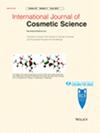Effect of low humidity on the barrier functions of keratinocytes in a reconstructed human epidermal model
Abstract
Objective
Dry skin occurs in the winter season when the relative humidity is low; however, the mechanism by which low humidity induces dry skin is not fully understood. To develop measures against dry skin in winter, understanding early changes in the skin upon exposure to low humidity is essential. This study employed a reconstructed human epidermal model (RHEM) to understand these changes.
Methods
The stratum corneum (SC) of RHEM was exposed to low-humidity air for 1 h, and trans-epidermal water loss (TEWL) and the penetration rate of lucifer yellow (LY) were measured. mRNA level expression of each target protein and the amounts of ceramides in RHEM were quantified using real-time PCR and LC-EIS/MS/MS, respectively. Protein localization in RHEM was visualized using immunostaining.
Results
Upon exposure to low humidity for 1 h, TEWL and LY penetration in the SC of RHEM were elevated. Even though there was no change in the amount of ceramides, the expression of cornified cell envelope (CCE) component proteins such as filaggrin (FLG) and loricrin (LOR) decreased. Furthermore, free SH and SS crosslink in SC of RHEM exposed to low humidity was decreased, and the SC became less hydrophobic. In tight junctions that contribute to barrier function, cloudin1 (CLDN1) and ZO-1 decreased upon exposure to low humidity.
Conclusion
Low humidity induces immature differentiation of the skin at an early stage characterized by corneocytes with CCE in fragile structures and reduced expression of tight junction proteins. Thus, it can be inferred that repeated exposure to dry air results in the repetition of these initial reactions, ultimately resulting in dry skin.

 求助内容:
求助内容: 应助结果提醒方式:
应助结果提醒方式:


